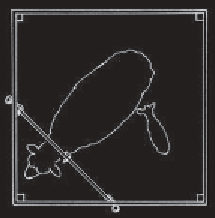Agriculture Reference
In-Depth Information
Forcible Acceptance
If all else fails in your grafting attempts, then it is time to get tough. One solu-
tion is to pen or tie the ewe in such a way that she cannot hurt the lamb and
it can nurse regularly in safety. You may need to tie her hind legs together
temporarily so she can't keep moving and preventing the lamb from nursing.
Without the mother's guidance and encouragement, you may need to help the
lamb nurse by holding the ewe and pushing the lamb to the right place.
If the ewe is a hard-core case, a ewe stanchion, which is designed to limit
the ewe's movement but still allows her to lie down, get up, and eat, could be
necessary. A less elaborate one can be improvised in the corner of the lambing
pen. Make sure the ewe has room to lie down and has plenty of hay and water
in front of her. Use molasses in the water, as you would for any ewe that has
just lambed. It may take from 1 to 5 days before the ewe is resigned to accept-
ing the lamb.
Caution:
Exercise care and judgment in the size of the lamb that you are
attempting to graft. An orphan lamb that is a week old may be so aggressive
at nursing that it will frighten the ewe. Also, if there is a signifi cant difference
in age and size between two lambs placed on a ewe, the weaker or younger
lamb may not be able to compete, and its growth can be stunted or it may be
starved out completely.
A small pen with a headgate can be used for grafting an orphan lamb onto a ewe or for
chores like crotching. While in the headgate, the ewe is free to lie down or stand up, and
to eat or drink from feed or water placed in the corner of the pen.
(This design comes from
MidWest Plan Ser vice [see Resources].)


